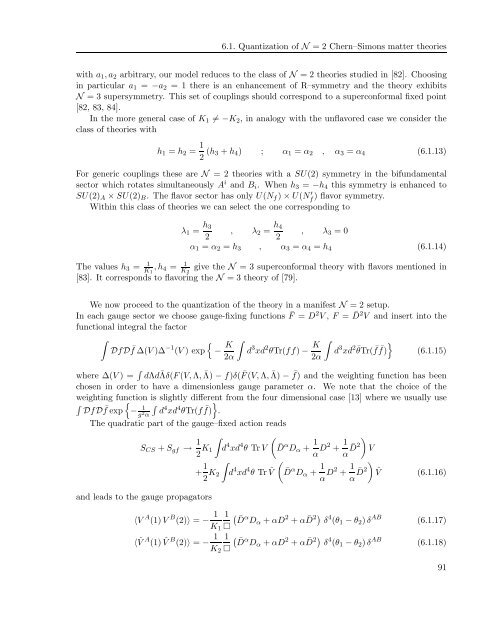Perturbative and non-perturbative infrared behavior of ...
Perturbative and non-perturbative infrared behavior of ...
Perturbative and non-perturbative infrared behavior of ...
You also want an ePaper? Increase the reach of your titles
YUMPU automatically turns print PDFs into web optimized ePapers that Google loves.
6.1. Quantization <strong>of</strong> N = 2 Chern–Simons matter theories<br />
with a1,a2 arbitrary, our model reduces to the class <strong>of</strong> N = 2 theories studied in [82]. Choosing<br />
in particular a1 = −a2 = 1 there is an enhancement <strong>of</strong> R–symmetry <strong>and</strong> the theory exhibits<br />
N = 3 supersymmetry. This set <strong>of</strong> couplings should correspond to a superconformal fixed point<br />
[82, 83, 84].<br />
In the more general case <strong>of</strong> K1 = −K2, in analogy with the unflavored case we consider the<br />
class <strong>of</strong> theories with<br />
h1 = h2 = 1<br />
2 (h3 + h4) ; α1 = α2 , α3 = α4 (6.1.13)<br />
For generic couplings these are N = 2 theories with a SU(2) symmetry in the bifundamental<br />
sector which rotates simultaneously Ai <strong>and</strong> Bi. When h3 = −h4 this symmetry is enhanced to<br />
SU(2)A × SU(2)B. The flavor sector has only U(Nf) × U(N ′ f ) flavor symmetry.<br />
Within this class <strong>of</strong> theories we can select the one corresponding to<br />
The values h3 = 1<br />
K1 ,h4 = 1<br />
K2<br />
2<br />
, λ2 = h4<br />
2<br />
, λ3 = 0<br />
α1 = α2 = h3 , α3 = α4 = h4 (6.1.14)<br />
λ1 = h3<br />
give the N = 3 superconformal theory with flavors mentioned in<br />
[83]. It corresponds to flavoring the N = 3 theory <strong>of</strong> [79].<br />
We now proceed to the quantization <strong>of</strong> the theory in a manifest N = 2 setup.<br />
In each gauge sector we choose gauge-fixing functions ¯ F = D 2 V , F = ¯ D 2 V <strong>and</strong> insert into the<br />
functional integral the factor<br />
<br />
DfD ¯ f ∆(V )∆ −1 <br />
(V ) exp − K<br />
<br />
2α<br />
d 3 xd 2 θTr(ff) − K<br />
<br />
2α<br />
d 3 xd 2¯<br />
<br />
θTr( f¯f) ¯<br />
(6.1.15)<br />
where ∆(V ) = dΛd¯ Λδ(F(V,Λ, ¯ Λ) − f)δ( ¯ F(V,Λ, ¯ Λ) − ¯ f) <strong>and</strong> the weighting function has been<br />
chosen in order to have a dimensionless gauge parameter α. We note that the choice <strong>of</strong> the<br />
weighting function is slightly different from the four dimensional case [13] where we usually use<br />
<br />
DfDf¯ exp − 1<br />
g2 <br />
d4xd4θTr(f f) ¯ .<br />
α<br />
The quadratic part <strong>of</strong> the gauge–fixed action reads<br />
SCS + Sgf → 1<br />
2 K1<br />
<br />
d 4 xd 4 <br />
θ Tr V ¯D α Dα + 1<br />
α D2 + 1<br />
α ¯ D 2<br />
<br />
V<br />
+ 1<br />
2 K2<br />
<br />
d 4 xd 4 θ Tr ˆ <br />
V ¯D α Dα + 1<br />
α D2 + 1<br />
α ¯ D 2<br />
<br />
ˆV (6.1.16)<br />
<strong>and</strong> leads to the gauge propagators<br />
〈V A (1)V B (2)〉 = − 1<br />
K1<br />
〈 ˆ V A (1) ˆ V B (2)〉 = − 1<br />
K2<br />
1 <br />
¯D α<br />
Dα + αD<br />
<br />
2 + α ¯ D 2 δ 4 (θ1 − θ2)δ AB<br />
1 <br />
¯D α<br />
Dα + αD<br />
<br />
2 + α ¯ D 2 δ 4 (θ1 − θ2)δ AB<br />
(6.1.17)<br />
(6.1.18)<br />
91
















